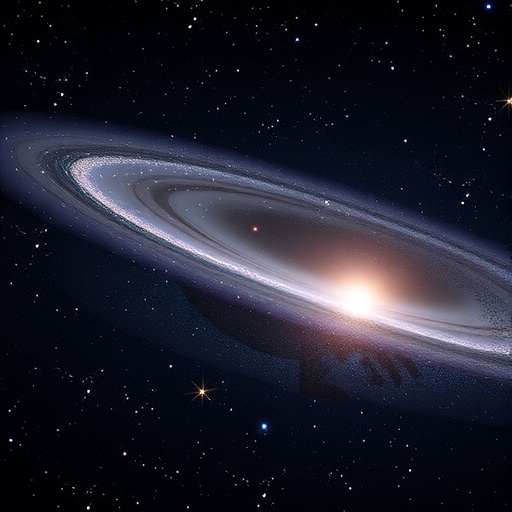In a significant development within the astrophysical community, researchers have unearthed a groundbreaking pathway that identifies the origins of some of the fastest stars within our galaxy. These stellar bodies, known as hypervelocity white dwarfs, are remarkable remnants of stars that, due to specific astrophysical events, are now hurtling through space at speeds greater than 2000 kilometers per second. Such extreme velocities not only challenge our understanding of stellar dynamics but also reshape our insights into the lifecycle of stars and the processes that govern their evolution.
The research, spearheaded by Dr. Hila Glanz from the Technion – Israel Institute of Technology, involved an international collaboration dedicated to understanding the phenomena surrounding these hypervelocity white dwarfs. Through advanced three-dimensional hydrodynamic simulations, the team meticulously explored the merging process of two rare hybrid helium-carbon-oxygen white dwarfs, which serve as the primary candidates in this stellar scenario. The simulations provided a detailed look into the cataclysmic events that unfold during such mergers, offering a glimpse into stellar interactions that often result in spectacular outcomes.
The results of these simulations are nothing short of vigorous. As described by the researchers, the lighter of the two merging white dwarfs experiences partial disruption during the merger, immediately resulting in a chain reaction. The heavier white dwarf, undergoing what is termed a double-detonation explosion, launches the surviving remnant at astonishing speeds that enable it to escape the gravitational constraints of the Milky Way galaxy. Such discoveries not only explain the hypervelocity aspect of these stars but also align with observational data regarding their characteristics, thus providing a sound hypothesis for their origins.
One of the standout aspects of this study is that it offers a thorough explanation for previously observed hot, faint white dwarfs that appear in the galactic halo. Dr. Glanz emphasizes that this marks the first instance where a clear pathway to the formation of hypervelocity remnants has been established. This breakthrough resolves long-standing queries concerning these enigmatic stars and builds a bridge to understanding various peculiar Type Ia supernovae linked to such stellar phenomena, offering a comprehensive view of the lifecycle of stellar remnants.
As the astrophysical community remains keenly interested in hypervelocity stars, this research is poised to shift paradigms. The authors explain that their pioneering model encapsulates both the extreme velocities alongside the distinct thermal and luminosity characteristics of known hypervelocity white dwarfs. Examples such as the stars J0546 and J0927 illustrate the precision with which these new findings correlate with observed data, suggesting that the origins of these massive stellar bodies are far more complex and interconnected than previously understood.
Moreover, the implications of this research extend beyond just the hypervelocity stars themselves. The authors highlight that the behavior of these stars following their dramatic birth is a critical component in decoding the various types of thermonuclear explosions observed in the cosmos. These events hold paramount importance, especially in terms of measuring cosmic expansion and deducing the foundational processes that lead to the formation of chemical elements within galaxies.
The collaborative nature of this study, involving teams from the Technion, Universität Potsdam, and the Max Planck Institute for Astrophysics, underscores the integration of theoretical and computational astrophysics in addressing profound cosmic mysteries. Combining high-performance simulations with rigorous theoretical modeling, the research team has forged a comprehensive narrative regarding the lifecycle of these hypervelocity white dwarfs, illuminating the path forward for future studies.
As the field of astrophysics continues to evolve, upcoming transient surveys and data from the Gaia space telescope are anticipated to unveil even more of these elusive stellar missiles traversing the galaxy at mind-bending speeds. This study lays the groundwork for future investigations that could further untangle the myriad complexities surrounding stellar evolution and explosion mechanisms.
In summary, the discovery of a new origin for hypervelocity white dwarfs not only serves as a significant advancement in our understanding of stellar dynamics but also presents a myriad of questions for future exploration. By establishing a coherent narrative surrounding the transition of these stellar remnants, this research opens new avenues for scientific inquiry, melding theoretical understanding with empirical observation in the quest to grasp the expansive and often bewildering nature of our universe.
As the scientific community eagerly awaits the next chapter in this ongoing saga, the study encapsulates a shared commitment to unraveling the fabric of the cosmos, one discovery at a time. The journey through the cosmos is marked by such milestones which not only redefine our existing frameworks but also inspire the next generations of astrophysicists and explorers.
Subject of Research:
Article Title: The origin of hypervelocity white dwarfs in the merger disruption of He–C–O white dwarfs
News Publication Date: 19-Aug-2025
Web References:
References:
Image Credits: Credit: Technion Spokesperson’s Office
Keywords
Hypervelocity White Dwarfs, Stellar Evolution, Supernova Explosion, Astrophysical Dynamics, Hydrodyamic Simulations, Galactic Halo, Thermonuclear Explosions, Cosmic Expansion, Astrophysics Research.




